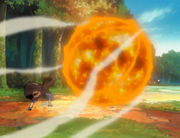(:D found this on wiki Apparently this is a (direct) quote from Kishimoto-sensei. The one before sounds the same but so different at the same time) |
No edit summary Tag: sourceedit |
||
| (46 intermediate revisions by 28 users not shown) | |||
| Line 1: | Line 1: | ||
| − | [[File: |
+ | [[File:Rasengan.png|thumb|left|The [[Rasengan]] is an example of ninjutsu.]] |
| − | <section begin=summary />{{translation|'''Ninjutsu'''|忍術|lit meaning=Ninja Techniques}}, is a |
+ | <section begin=summary />{{translation|'''Ninjutsu'''|忍術|lit meaning=Ninja Techniques}}, is a term referring to almost any [[technique]] which allows the user to do something that they otherwise would be incapable of doing, including the usage of [[weapons]].<section end=summary /> Unlike [[genjutsu]], which makes the opponent see illusions, the effects of ninjutsu are real. They vary greatly in purpose, with the simpler ninjutsu serving such tasks as transforming the user or allowing them to evade attacks. These techniques are often second-nature for experienced shinobi, who can use them at will. More complex ninjutsu manipulate one's surroundings or utilise the elements, respectively serving such tasks as [[Medical Ninjutsu|healing]] others or manipulating [[nature transformation]]s. |
| − | Ninjutsu, most of the time, relies on chakra and [[hand seals]] to be effective. The hands are put in sequential positions that moulds and manipulates chakra in the necessary manner to perform a technique. This is not always needed, however, and some techniques become second nature to experienced ninja, after which they can perform them at will. |
+ | Ninjutsu, most of the time, relies on [[chakra]] and [[hand seals]] to be effective. The hands are put in sequential positions that moulds and manipulates chakra in the necessary manner to perform a technique. This is not always needed, however, and some techniques become second nature to experienced ninja, after which they can perform them at will. |
[[File:Grandfire Ball.PNG|thumb|right|An example of shape and nature manipulation combined.]] |
[[File:Grandfire Ball.PNG|thumb|right|An example of shape and nature manipulation combined.]] |
||
| + | Additionally, there is the kind of technique that can be classified as a basic or advanced elemental technique, the [[Elements#Basic Types|basic type]] are techniques with specific elements ([[wind]], [[water]], [[fire]], [[earth]], or [[lightning]]), the [[Elements#Advanced Types|advanced type]] combine two or three of the basics elements and creates a new one. |
||
| ⚫ | |||
| ⚫ | |||
| ⚫ | |||
| ⚫ | |||
| ⚫ | |||
| ⚫ | |||
| ⚫ | |||
| ⚫ | |||
| ⚫ | It is said that the [[Sage of the Six Paths]] was the first to explain the mysteries of chakra, |
||
| ⚫ | It is said that the [[Sage of the Six Paths]] was the first to explain the mysteries of chakra, travelling throughout the world to spread his ideas and religion, the {{translation|[[ninshū]]|忍宗|lit meaning=Shinobi Sect}}. The teachings were meant to give people a better understanding of themselves, as well as others, and lead the world into an era of peace. However, as time wore on, ninshū would eventually come to be known as ninjutsu, which according to him, was made to create war. |
||
| ⚫ | |||
| + | |||
| ⚫ | |||
== See Also == |
== See Also == |
||
| Line 20: | Line 22: | ||
[[Category:Jutsu Type]] |
[[Category:Jutsu Type]] |
||
| + | |||
| + | [[de:Nin-Jutsu]] |
||
| + | [[id:Ninjutsu]] |
||
| + | [[ka:ნინძიუცუ]] |
||
| + | [[ru:Ниндзюцу]] |
||
Revision as of 13:54, 2 July 2015

The Rasengan is an example of ninjutsu.
Ninjutsu (忍術, literally meaning: Ninja Techniques), is a term referring to almost any technique which allows the user to do something that they otherwise would be incapable of doing, including the usage of weapons. Unlike genjutsu, which makes the opponent see illusions, the effects of ninjutsu are real. They vary greatly in purpose, with the simpler ninjutsu serving such tasks as transforming the user or allowing them to evade attacks. These techniques are often second-nature for experienced shinobi, who can use them at will. More complex ninjutsu manipulate one's surroundings or utilise the elements, respectively serving such tasks as healing others or manipulating nature transformations.
Ninjutsu, most of the time, relies on chakra and hand seals to be effective. The hands are put in sequential positions that moulds and manipulates chakra in the necessary manner to perform a technique. This is not always needed, however, and some techniques become second nature to experienced ninja, after which they can perform them at will.

An example of shape and nature manipulation combined.
Additionally, there is the kind of technique that can be classified as a basic or advanced elemental technique, the basic type are techniques with specific elements (wind, water, fire, earth, or lightning), the advanced type combine two or three of the basics elements and creates a new one.
When creating a ninjutsu, the two methods of manipulating chakra are referred to as shape transformation and nature transformation:
- Shape transformation deals with controlling the form, movement, and potency of chakra.
- Nature transformation usually deals with changing the physical properties of chakra into an element.
These two methods can be implemented separately or together in order to create a ninjutsu.
It is said that the Sage of the Six Paths was the first to explain the mysteries of chakra, travelling throughout the world to spread his ideas and religion, the ninshū (忍宗, literally meaning: Shinobi Sect). The teachings were meant to give people a better understanding of themselves, as well as others, and lead the world into an era of peace. However, as time wore on, ninshū would eventually come to be known as ninjutsu, which according to him, was made to create war.
Ninjutsu can be used in collaboration with taijutsu to create nintaijutsu techniques.
